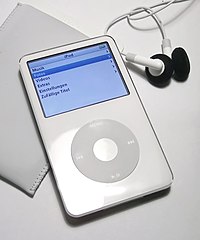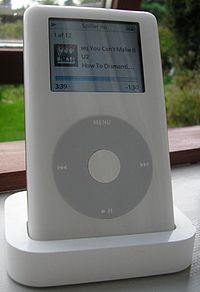Ipod Touch
 The specifications as listed on Apple's website for the second generation iPod Touch are:
The specifications as listed on Apple's website for the second generation iPod Touch are:
Screen material: Arsenic-free glass
Screen size: 8.9 cm (3.5 in)Screen resolution: 480×320 px at 163 ppi, with 3:2 aspect ratio
Input method: Multi-touch screen interface, Sleep/Wake button, Accelerometer, Home button, Volume Rocker buttons
Operating system: iPhone OS (current version 2.2)
Storage: 8, 16, or 32 GB flash memory
CPU: ARM 400 MHz for 1st gen, 533 MHz for 2nd GenGPU:
PowerVR MBX Lite 3
DRAM: 128 MB DRAMWi-Fi (802.11 b/g)
Built-in rechargeable, non-removable lithium battery with up to 6 hours of video playback, and up to 36 hours of audio playback, times vary.
Built-in audio speaker.[19]3.5 mm
audio output jackSize: 110×61.8×8 mm (4.3×2.4×0.33 in)
Weight: 115 g (4.05 oz)
Direct iTunes Wi-Fi Music Store accessWidescreen videoIncluded applications: Safari web browser, YouTube client, Mail client, Google MapsAccess to App Store (requires iPhone OS 2.0 or later)Widgets: Stocks, Weather, NotesAccess to Starbucks music (available only in selected cities across the United States)
Description
The iPod Touch has the iPhone's multi-touch interface, with a physical home button off the touch screen. The home screen has a list of buttons for the available applications. The iPod Touch is equipped with Wi-Fi 802.11b/g. All iPod Touch models have included the applications Music, Videos, and Photos (collectively duplicating the standard functions of the iPod Classic), iTunes (providing access to the Wi-Fi Music Store), Safari, YouTube, Calendar, Contacts, Clock, Calculator, and Settings. Later models added Mail (accessing POP/IMAP/SMTP e-mail), Maps, Stocks, Notes, and Weather, which could also be added to the earlier models with the purchase of a US$20 software upgrade. Direct links to web sites can be added to the home screen by the user (called "Web Clips").
On July 11, 2008 the iPhone 2.0 Software Update was released for the iPod Touch for US$9.95. The update allowed first generation iPod Touch devices to access the App Store, download third-party applications, in addition to a host of minor "fixes". The iPod Touch 2.0 Software Update supports WPA2 Enterprise with 802.1X authentication.
Requirements
As supplied new, the iPod Touch needs a connection to a computer for initial configuration. Officially, Apple requires iTunes to be installed on either a Mac OS X or Windows operating system based computer for configuring the iPod Touch. On either operating system, the iPod Touch must be connected through a USB port.The first time the iPod Touch is turned on, a "connect cable to iTunes" graphic will be displayed continuously until the iPod Touch is connected to a computer running iTunes.
To use the iPod Touch for buying products at the iTunes Wi-Fi Music Store via Wi-Fi, an iTunes Store account must be created in iTunes and the account details then entered into the iPod.
Apple states that the following is required for the iPod Touch:
A computer running either:
Mac OS X 10.4.10 or later
Microsoft Windows XP with SP2 or later, or Vista (32 or 64-bit versions)
iTunes 8.0 (with the 2.1 iPhone OS update) or 7.6 for iPhone OS 2.0.x or earlier
Available USB 2.0 port

















+(Custom).png)